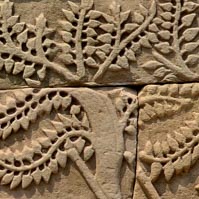
The German Angkor Illustration Project
• G • A • I • P •
Banteay Chhmar ("Citadel Narrow") in the far north-west of Cambodia is the ancient Khmer's second largest stone construction, only Angkor Wat is more massive.
Banteay Chhmar is one of the two vast temple complexes outside Angkor constructed by Cambodia’s most prolific builder, Jayavarman VII (1181–ca. 1218). The other one is Prasat Bakan (also called Preah Khan Kompong Svay), which was modified by this king. These two monuments are the only edifices outside Angkor carrying those enigmatic face-towers of the Buddhist era. Particularly Jayavarman's new capital Angkor Thom, its city gates and its central temple Bayon, are world-famous for those monumental smiling Buddha (or Bodhisattva) faces at the four cardinal points of the upper parts of the buildings. Furthermore, Banteay Chhmar has an outer gallery very similar to that of Angkor Thom's state temple Bayon, carved with bas-reliefs depicting troups parading and in combat and religious motifs as well as scenes of daily Khmer life.
Banteay Chhmar was erected on a site of an ninth century Hindu sanctuary attributed to the half-legendary founder of the Angkor empire, Jayavarman II. The simultaneous dedication of Jayavarman VII's Buddhist complex to Hindu divinities shows the religious tolerance of the Buddhist king at the time of construction. Banteay Chhmar's central shrine once held an image of the crown prince, probably his son and, in the surrounding corners, of four of his royal servants. According to a detailed inscription in Khmer language (K.227) these four loyal servants of the prince lost their lives for his defense against Cham enemies.
The complex is oriented eastwards. To the east of the main sanctuary, there was a Baray with a Mebon temple on a central island. The reservoir, now dried up, was about 1.6 km long and 0.6 km wide. Banteay Chhmar is surrounded by some more Buddhist temples, in a strinkingly regular pattern. Noteworthy are those in the four cardinal directions as they show the nicest examples of those face-towers mentioned above. (More face-towers are surmounting the inner galleries of the main temple.) The best preserved one is Ta Prohm to the south, the most secluded one is Samnang Tasok in the jungles to the west, hidden in thicket and not easy to find. After rainfall Samnang Tasok could still be reached, but your shoes would be soaked.
The principal structure of Banteay Chhmar has three enclosures, as usual. The external one (counted as third) is ruined, it was surrounded by a moat and measures 1900 m by 1700 m. Like Angkor Wat and Angkor Thom, Banteay Chhmar originally enclosed a whole city with the 5 hectares large main temple structure being the core. Four stelae with inscriptions reporting Jayavarman VII's genealogy were placed at the four corners of this third enclosure wall, just as in the case of the capital Angkor Thom's four corner-shrines that are called Prasat Chrung.
The middle (second) enclosure, with an inner moat, is 850 long and 800 m wide. The inner (first) enclosure is the gallery displaying those huge-scale and detailed bas-reliefs mentioned above. The walls were 250 m long and 200 m wide. Some parts are broken or even deliberately demolished. The relief bands belong to the three largest in Khmer history, besides Angkor Wat and Bayon. On the wester side remain two unique depictions of the multi-armed Lokeshvara (Avalokiteshwara). They became the landmarks of Banteay Chhmar. Originally, there were six more of them, but in January 1999 art thefts dismantled whole sections of this gallery wall with those exceptional works of ancient Khmer art.
Within the first enclosure there is a jumble of towers and galleries, engulfed by tropical foliage and almost without passage ways because of piles of broken stones. Indeed, Banteay Chhmar is a "lost temple in the jungle" par excellence. Throughout this labyrinthic complex, remnants of beautiful carvings can be seen on fallen stones.
Banteay Chhmar was severely looted, particularly during the civil war time in the 1980s and the first half of the 1990s, when this area was close to the headquarter of the Khmer Rouge guerilla. Apart from extorting food and payments from the farmers, art theft and trafficking was one of the sources of income for the Khmer Rouge guerilla army. But looting even by members of the army continued after the civil war, because of Banteay Chhmar's remote location and the proximity to the Thai border. Stolen Khmer property usually is sold in Thailand. In 2002 the temple still was listed as one of the world's most endangered heritage sites by the World Monuments Fund.
After the collapse of the southwestern tower in 2003, the World Monuments Fund launched a research program including a survey of the hazardous vegetation. The WMF managed to secure private funding for the removal of dangerous trees and measures to improve the stability of remaining structures and for training local conservational staff.
Ernst Ando Sundermann
• G • A • I • P •
Copyright © 2016 khmer-heritage.de